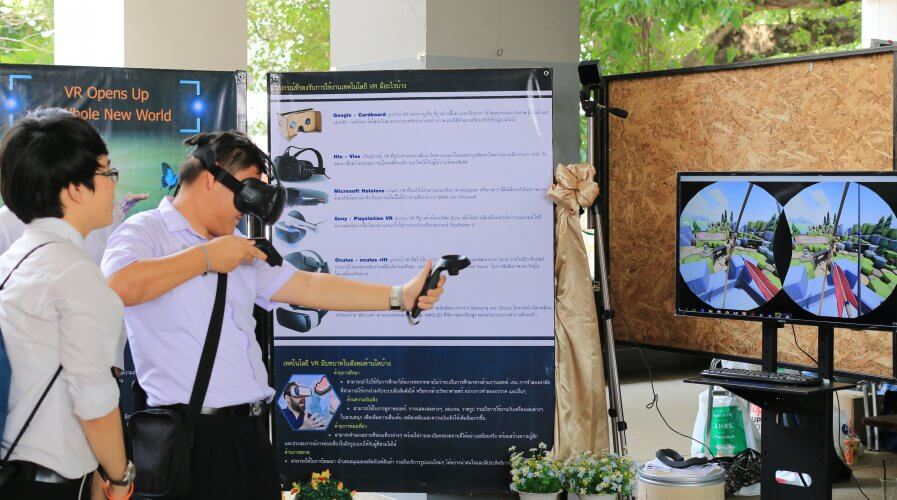
Virtual reality is one type of technology that is being used in remote training sessions. Source: Shutterstock
Why virtual learning should be a priority for businesses right now
In the last month or so, many businesses have faced little choice but to ‘go virtual’.
Ever since the world has been told to practice social distancing and obey quarantine measures, a lot of business establishments have hosted their operations in cyberspace.
Such changes are not only enforced on office-based businesses; live events and conferences – event that would usually see thousands of people rubbing shoulders and shaking hands – have also been pushed to be conducted virtually.
Shanghai Fashion Week, for example, collaborated with Alibaba‘s online marketplace Tmall and its live-streaming channel Taobao Live to see that the show went on – and it did, successfully.
Global software firm Cisco, meanwhile, launched its first fully-virtual event for the APAC region on various platforms including here, on Tech Wire Asia.
However, not all forms of businesses are able to go virtual in times of crisis. Many operations have to shut their doors to support governmental efforts in containing the virus, but that does not mean that they won’t be able to make a comeback.
Some businesses are already way ahead by thinking about how to best spur operational growth and sales when the world ‘resumes’.
Faced with a long road to recovery, many will be reevaluating their operations and investments, and significant decisions could follow that change the ways their businesses, and subsequently their employees, work.
Furloughed businesses that are fortunate enough to have some financial security to weather the crisis may see it as the opportune time to invest in transformational technology that they have, thus far, delayed integrating.
Technology, such as automation – whether that’s deploying robotic handlers in a warehouse or deploying RPA software for logistics efficiency – will be essential in helping businesses cope with possible economic recession, slowed-down earnings, and the necessary restrictions that will remain for quite some time, even after quarantine orders are lifted.
But the questions that businesses still need to answer are these: Can the current workforce support the operation through this transformation? And how can organizations prepare their team members for these sorts of changes, particularly in the absence of physical in-person training sessions and workshops?
Can’t work? Then train
Steve Wainwright, the Managing Director EMEA at Skillsoft, told TechHQ: “In any time of instability or rapid change, ensuring employees are able to acquire and develop new skills is vital.”
Training employees now will be key to a post-COVID-19 business environment. The realization that many operations wouldn’t even have to be halted if it wasn’t for a lack of labor will boost the consideration into and adoption of automation tools.
But what would automation make of these employees when manual workloads are relieved? Well, it means they would be available for high-skill tasks and mentally demanding roles that would be critical to support the regrowth of halted operations.
One of the key gaps is in regard to digital skills, which is where virtual training can come in handy.
By leveraging interactive and collaborative technologies and educational technologies (EdTech) like virtual reality (VR), augmented reality, discussion platforms, and conferencing software, businesses can host training sessions for their employees or new recruits.
Taking this approach can ensure they remain reassured, engaged, energized and, crucially, reskilled and upskilled, ready to take on newly-formed roles once they’re back in the workplace.
In industries where the pandemic has hit the hardest like the hospitality, hotels are counting on virtual reality (VR) technology to continue training their employees and boost productivity, virtually.
In Myanmar, for example, a global learning consultancy, Passport to Success, is pushing forward its VR learning module to deliver soft skill and language training to displaced hotel staff in hotels in Myanmar as well as Thailand.
As a result, hotel staff can return with better management and people skills, helping operations regain lost ground more quickly in the year to come.
Training companies like Code Nation are offering businesses a means to develop their staff with new IT and programming skills. Through its coding classes that leverage the latest EdTech, furloughed workers or interested individuals can make use of the downtime, retraining themselves to be software developers.
Retrained workers can then return to the working world when the pandemic with new career prospects, higher employment value and improved ability to support the business in the next stage of its transformation journey.
That’s the key here; to leverage the downtime most businesses are facing by training, retraining, reskilling, and upskilling the workforce with new digital abilities, new knowledge and a new understanding of how to adapt to the operational changes that will take place post-COVID-19 – because businesses will need to change, without a doubt.
At the same time, providing employees with these kinds of opportunities in the absence of work is a form of investment that would greatly benefit the operation, keeping workers motivated, and with a sense of purpose, to weather this unprecedented period.
“This isn’t just about helping the organization navigate uncertainty; it’s about providing a sense of self-fulfilment to remote workers that their continued development is valued by the organization,” said Wainwright.
“Organizations can embrace this aspect of remote working with intelligent learning technologies that help employees sustain their productivity, collaborate effectively and take control of their own professional wellbeing.”
READ MORE
- The criticality of endpoint management in cybersecurity and operations
- Ethical AI: The renewed importance of safeguarding data and customer privacy in Generative AI applications
- How Japan balances AI-driven opportunities with cybersecurity needs
- Deploying SASE: Benchmarking your approach
- Insurance everywhere all at once: the digital transformation of the APAC insurance industry


